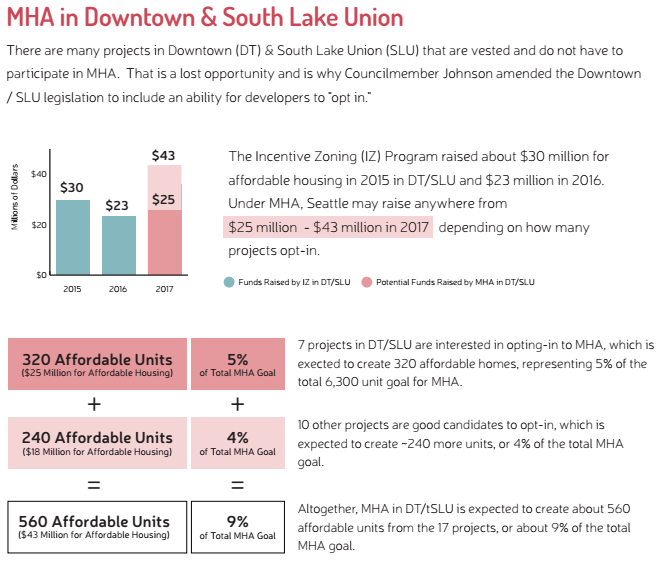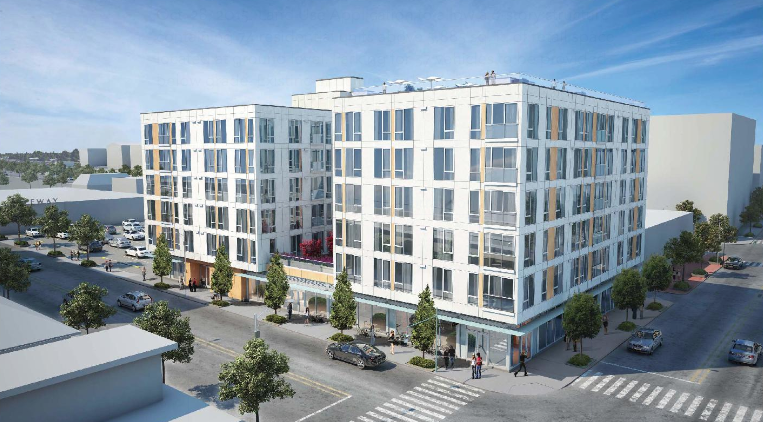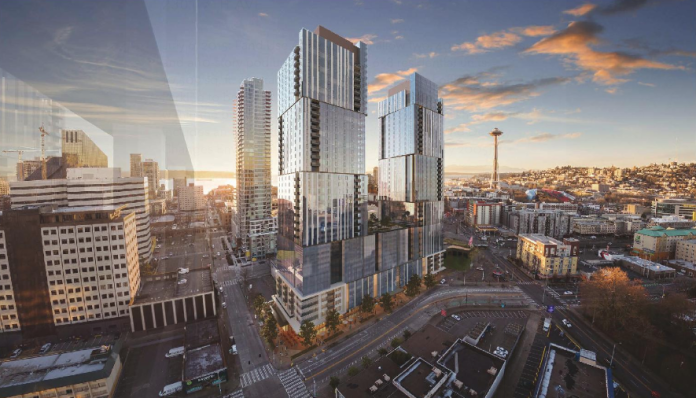Seattle recently rezoned large swaths of Downtown and South Lake Union and the University District in the hopes of increasing development capacity for new development and delivering affordable housing. The rezones were paired with Mandatory Housing Affordability (MHA) requirements giving a choice to developers to build affordable units or pay the City a fee to create affordable housing units instead. The MHA program applies to most new multi-family residential and commercial development, though the rates differ by zone and use.
Before passing the Downtown and South Lake Union rezones, Councilmember Rob Johnson (District 4, Northeast Seattle) sponsored a provision (referred to as the “opt-in provision”) allowing developers with vested development projects to revise their project proposals so as to use added development capacity from the rezone changes if they choose to voluntarily participate in the MHA program. In other words, developers could benefit from the zoning changes without having to restart the permitting process while generating affordable housing that may not otherwise be realized. Some developers already appear poised to do just that.
Yesterday, Councilmember Johnson held a press conference at a windswept parking lot of a former gas station in the University District to highlight how the Downtown and South Lake Union opt-in provision is already generating serious interest amongst developers and how one developer in the University District is canceling his building permits to take advantage of the recent neighborhood rezone.
Councilmember Johnson reported that developers of seven projects in Downtown and South Lake Union have expressed interest in modifying their projects to use the opt-in provision. According to analysis by the Seattle Department of Construction and Inspections (SDCI), those seven projects are estimated to deliver $25 million for affordable housing using the in lieu fee payment option available under the MHA program. The SDCI estimate also suggests that approximately 320 affordable housing units could be produced using a mix of the in lieu fee payments and leveraging other sources, such as federal tax credits geared toward affordable housing developments. While the fee in lieu payments mean that affordable housing will not be provided on-site, City analysis shows that more affordable housing will be created in absolute terms due to the financing arrangements and design of the MHA program. Where affordable units are located by the City is through specific criteria, such as proximity to where the fees were derived, proximity to high quality transit, and proximity to an urban village or urban center.

Under the MHA framework, any units created through the fee lieu payment option are required to be rented to households with incomes at or below 60% of the area median income for at least 50 years or sold as ownership units to households with incomes at or below 80% of the area median income for a minimum period of 50 years. The United States Department of Housing and Urban Development (HUD) modifies area median income limits by households annually. For a single individual, an income of $43,680 would constitute 60% of the area median income whereas a family of four making an income of $57,600 would.
Developers shepherding another 10 projects in Downtown and SLU through the land use permitting process could elect to opt-in as well. Their participation in the MHA program could net another $18 million and 240 affordable housing units*. Between these 17 projects, a total of $43 million could be put towards development of 560 affordable housing units*, representing 9% of the City’s 10-year to create 6,000 affordable housing units through the MHA program. *Again, leveraging other financing sources in addition to the in lieu fees.

Councilmember Johnson lauded developers considering opting in:
What better way for us to celebrate Affordable Housing Week than to recognize these kinds of early successes indicating great momentum for the MHA program. Today I’ve asked our land use department to prioritize getting these seven projects opted into the MHA program, and I also call on the 10 projects identified as good candidates to opt in to help us meet our ambitious and critical goals.
Eran Fields, a California developer, shows how the MHA program is having a huge impact. Fields’ development company had plans for a low-rise mixed-use project on the former gas station site flanking the northeast corner of NE 47th St and Brooklyn Ave NE. His development company plans to abandon their already-issued land use and pending building permits for the site and start anew in order to take advantage of the recently approved University District rezone. Fields’ mixed-use project had already received design review and land use approvals, even submitting building permits to construct the six-story structure. A total of 74 residential units and 5,885 square feet of ground floor retail space had been planned, but no affordable housing was on the table as part of it.

Zoning for the site has gone from NC3-65 (a mixed-use zone with a 65-foot height limit) to SM-U 75-240 (a mixed-use zone with a flexible 75- to 240-foot height limit). In other words, zoning on the site could allow for a tower rising more than 20 stories.
Fields’s announcement may come as a surprise to some given that he’s walking away from a fully approved project to embark on a new one, but the immense amount of additional development capacity unlocked by the rezone and added premium that high-rise construction can command undoubtedly factored into the decision. Fields praised the rezone for other reasons though. “Dense urban development must be coupled with public benefits, such as affordable and family-friendly housing, public open spaces, and streetscaping, while stimulating new and varied housing choices and neighborhood-serving retail,” he said. “The new zoning embraces these requirements and responsibilities, and I look forward to redeveloping and converting an auto-oriented site and use into a building that defers to the values and vision of this newly adopted progressive zoning.” His new project will do just that.
The new project will be nearly twice the size as the last with 142 apartment units, meaning that 13 units will be set aside as affordable or $3.2 million in affordable housing contributions will be made to the City. Fields is also considering construction of two-bedroom units using the special family-sized floor area exemption allowed under the recent rezone. Other aspects of the rezone could require or incentivize the project to contribute to the development of Green Streets, be constructed to LEED Gold certification standards, purchase Transfer of Development Rights to preserve open space or historic structures in the neighborhood, and provide higher quality design techniques.
Councilmember Johnson, for his part, made a poignant statement on Fields’ ambitious decision to go bigger. “It is not lost on me that this site, a former gas station, represents an unsustainable, car-dependent past,” he said. “This new project represents our future vision for this city–an affordable, green, and vibrant future for Seattle and all of its current and future residents. And that is certainly something to celebrate.”
The title image is of the proposed Block V (2301 7th Avenue) development in the Denny Triangle, courtesy of Graphite and Clise Properties, Inc.
Stephen is a professional urban planner in Puget Sound with a passion for sustainable, livable, and diverse cities. He is especially interested in how policies, regulations, and programs can promote positive outcomes for communities. With stints in great cities like Bellingham and Cork, Stephen currently lives in Seattle. He primarily covers land use and transportation issues and has been with The Urbanist since 2014.



